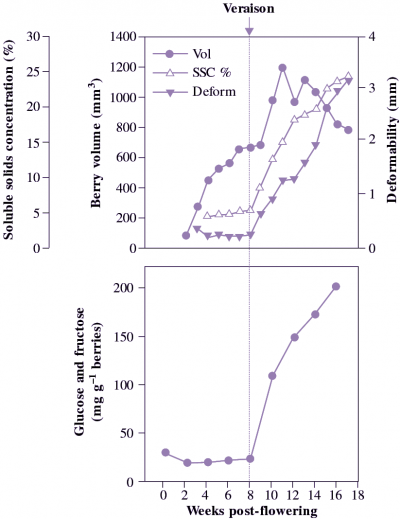In sugar-storing fruit a major shift in metabolism generally takes place when fruit expansion is almost complete, heralding a rapid increase in sugar content. Unloading of sugars from the phloem usually occurs by a symplastic route, but in some species is interrupted by an apoplastic step. Control points for sugar entry and accumulation by fruit include:
- Rate of sugar production by leaves and delivery to transport pathways;
- Reallocation of sugar from supporting vegetative growth towards fruit growth;
- Enhanced unloading of sugar from transport streams into fruit;
- Enhanced transfer of sugar across plasma membranes into cells or through plasmodesmatal connections between cells;
- Onward metabolism of sugar in the cytoplasm, or transfer to storage in vacuoles;
- Increased respiratory utilisation of sugar to provide energy for metabolic processes.
As with any biological system, multiple controls operate concurrently to drive a given pattern of maturation. Such events lead us to more robust indicators of ripeness, and improved ways of manipulating maturation to yield higher sugar content and better handling properties.
In tomato, there are different genotypes that accumulate either hexoses or sucrose. Most cultivars are hexose accumulators, in which acid invertase is active during growth and ripening. In transgenic tomatoes in which acid invertase activity was suppressed by expression of an antisense invertase transgene, sucrose accumulation occurred in a normally hexose-accumulating cultivar (Klann et al. 1996). Conventional breeding studies using crosses between sucrose-accumulating and hexose-accumulating types of tomato showed that an acid invertase gene is not transcribed during ripening of the sucrose accumulators, and that sucrose accumulators therefore lack acid invertase (Harada et al. 1995).
In melon, where sucrose is the main sugar to increase, there is a corresponding decrease in acid invertase and an increase in sucrose phosphate synthase (SPS) activity (this synthesises sucrose from hexose phosphate and adenylated precursors). A complex metabolic transition to allow sucrose accumulation occurs at the end of fruit growth and onset of ripening, of which the loss of soluble acid invertase activity is only one component (Dai et al. 2011).
However, in grape berries where hexoses begin to accumulate at veraison and reach very high levels (Figure 11.10), SPS, sucrose synthase and hexokinase activities all increase, but acid invertase mRNA abundance and activity both peak just prior to or at veraison and then decline. This suggests that in grape factors other than invertase activity regulate hexose accumulation. Two sucrose transporters were up-regulated at veraison, and it is possible that these regulate ripening-associated sugar accumulation from the apoplast into the parenchyma cells (Davies et al. 1999). Consistent with this suggestion, studies using tracers have shown that at veraison phloem unloading switches from a symplastic to an apoplastic route (Zhang et al. 2006).
